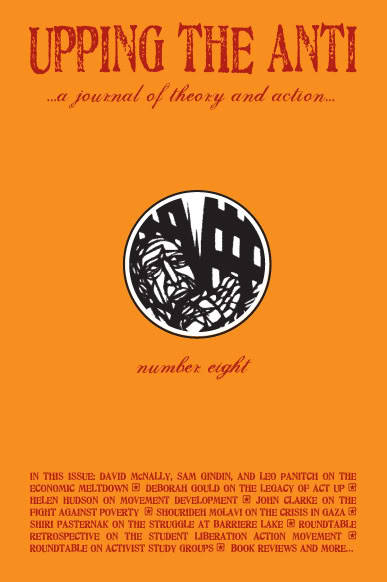 Upping the Anti out of Toronto, Canada is perhaps the hottest and best radical left theory/movement journal since it first began publication in late 2005. Releasing its eighth issue as of May 2009, the journal has provided a steady content of articles, interviews, reviews and topic based roundtables by and with movement activists and organizers on the radical left.
Upping the Anti out of Toronto, Canada is perhaps the hottest and best radical left theory/movement journal since it first began publication in late 2005. Releasing its eighth issue as of May 2009, the journal has provided a steady content of articles, interviews, reviews and topic based roundtables by and with movement activists and organizers on the radical left.
With the tag line “a journal of theory and action” the journal leans towards the more academic side. But unlike some of the more dense and long running left journals (Monthly Review comes to mind), the editorial collective and contributors are nearly all folks engaged in struggle and much of the theory and discussion comes directly out of movement organizing work. It’s not another left journal for radical college professors, but for folks in the movement trying to grapple with many of the difficult issues and conversations that those seeking to create revolutionary change should be. Perspective wise they maintain a pluralistic and non-party stance combined with anti-capitalism, anti-imperialist and anti-oppression politics (the three antis as they call them). Read reviews of issues #3 here and issues #2 and #3 here.
With this issue UTA brings us an interview “Contour of the Crisis” with three political economy instructors at York University in Toronto on the realities and opportunities for the left in the current financial meltdown (discussed above); “Movements Where People Can Grow” is an interview/discussuion with Helen Hudson (who among other groups is a board member of the Institute for Anarchist Studies, see their new spiffy website here) with her thoughts on building long-term and sustainable movements; a roundtable with former activists of SLAM (Student Liberation Action Movement, audio archive here) active in opposing tuition increases in the New York public university system in the 1990′s and discussing their strong leadership from women of color; and another roundtable with members of various study groups/circles taken up by radicals in a number of cities.
 Also, here’s a quote from the back cover of this issue that warms my heart from Helen Kellar, the advocate for the blind. Often left out of history is her radical politics as an anarchist and member of the IWW.
Also, here’s a quote from the back cover of this issue that warms my heart from Helen Kellar, the advocate for the blind. Often left out of history is her radical politics as an anarchist and member of the IWW.
Capitalism will inevitably find itself face to face with a starving multitude of unemployed workers demanding food or destruction of the social order that has starved them and robbed them of their jobs. in such a crisis the capitalism class cannot save itself… Its police and armies will be powerless to put down the revolt. (1918)
Here is also a quote on how she first moved towards radical politics from her Wikipedia entry…
I was appointed on a commission to investigate the conditions of the blind. For the first time I, who had thought blindness a misfortune beyond human control, found that too much of it was traceable to wrong industrial conditions, often caused by the selfishness and greed of employers. And the social evil contributed its share. I found that poverty drove women to a life of shame [referring to prostitution and syphilis] that ended in blindness.
Filed under: Announcement, Labor, the left, The Movement, Theory, Uncategorized | Tagged: economic crisis, Helen Keller, IWW, Student Liberation Action Movement, the left, Theory, Upping the Anti | Leave a Comment »




 An interesting, but sadly all too brief overview on the election of left-wing governments across Latin America and their relationship with social movements. Raises interesting parallels and questions about the relationship between Obama and left social movements in the US.
An interesting, but sadly all too brief overview on the election of left-wing governments across Latin America and their relationship with social movements. Raises interesting parallels and questions about the relationship between Obama and left social movements in the US.